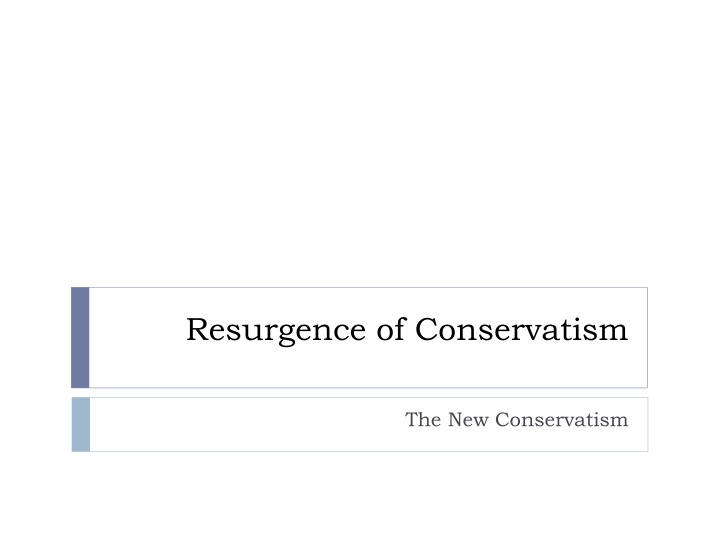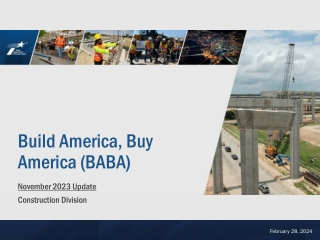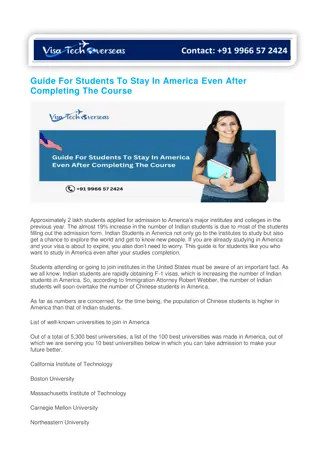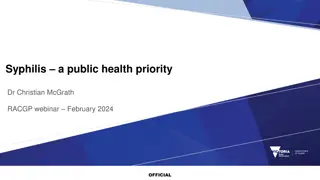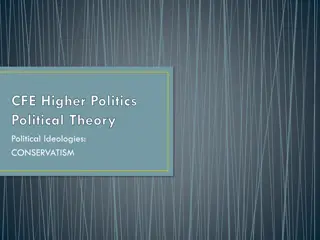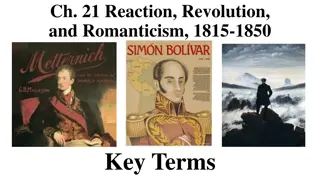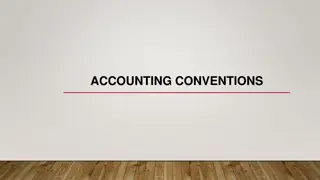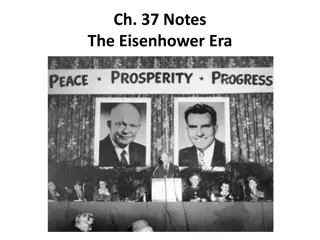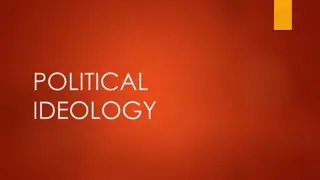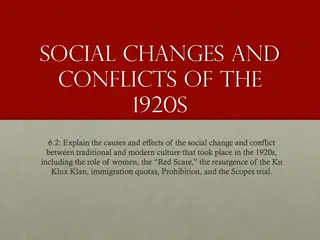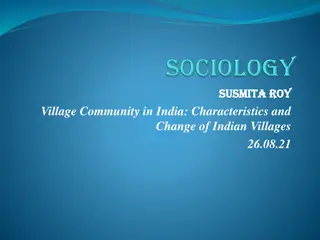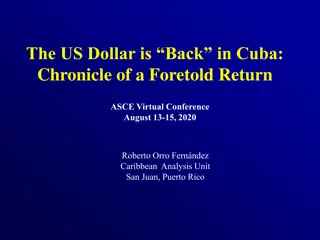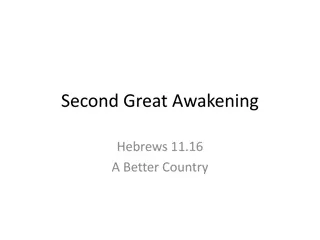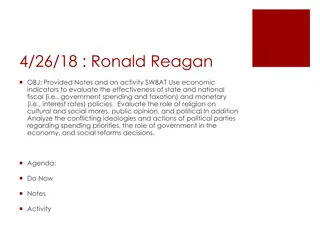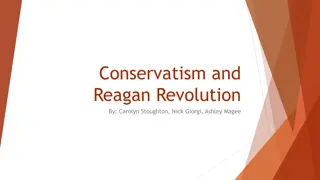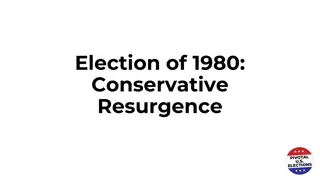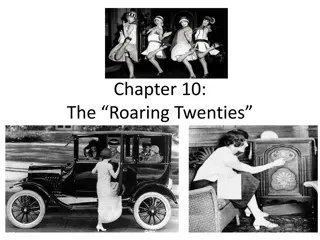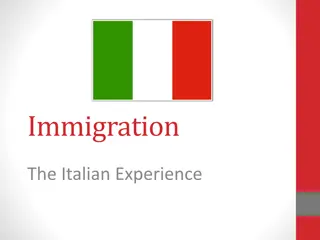The Resurgence of Conservatism in America
The resurgence of conservatism in America has brought about a clear distinction between conservative and liberal ideologies. Conservatives emphasize limited government intervention, promoting free-market principles, individual liberty, and moral values. On the other hand, liberals advocate for government intervention in the economy to address social issues and economic inequality. This ideological divide has shaped American politics, with conservatives organizing movements and gaining support, particularly in the Sunbelt region. The clash between these ideologies reflects broader societal debates on governance, wealth redistribution, and individual freedoms.
Download Presentation

Please find below an Image/Link to download the presentation.
The content on the website is provided AS IS for your information and personal use only. It may not be sold, licensed, or shared on other websites without obtaining consent from the author.If you encounter any issues during the download, it is possible that the publisher has removed the file from their server.
You are allowed to download the files provided on this website for personal or commercial use, subject to the condition that they are used lawfully. All files are the property of their respective owners.
The content on the website is provided AS IS for your information and personal use only. It may not be sold, licensed, or shared on other websites without obtaining consent from the author.
E N D
Presentation Transcript
Resurgence of Conservatism The New Conservatism
Conservatism and Liberalism Liberalism In America politics today, people who call themselves liberals (democrats) believe basic ideas. Although liberals favor government intervention in the economy, they are suspicious of any attempt by the government to regulate social behavior. They are strong supporters of free speech and privacy. They believe that most social problems have their roots in economic inequality. Liberals generally supported high taxes on the wealthy, partly because the taxes weaken the power of the rich and partly because the government can transfer the wealth over to Americans to keep society more equal.
Conservatism and Liberalism Conservatism Unlike liberals, conservatives generally have a fundamental distrust of the power of government, they support governmental powers divided between the state and federal levels. Conservatives believe that if the government regulates the economy, it makes the economy less efficient, resulting in less wealth and more poverty. They believe most social problems result from issues of morality and character-issues that are best addressed through religious faith and through private efforts. Conservatives generally oppose high taxes and government programs that transfer the wealth from the rich to those less wealthy. They believe that taxes and government programs not only discourage investment and take away people s incentive to work hard but also reduce the amount of freedom in society.
Conservatism Revives Conservatism and the Cold War Some Americans believed that liberal economic ideas were slowly leading the United States toward communism. Communism rejects religion and emphasizes the material side of life.
Conservatism Revives Conservatives Organize William F. Buckley founded a new conservative magazine called National Review. Buckley founded Young Americans for freedom (YAF) By 1964 the new conservative movement had achieved enough influence with in the Republican Party to enable the conservative Barry Goldwater to win the nomination for president.
Conservatism Gains Support The Rise of the Sunbelt One of the problems facing conservatives in the 1950s and early 1960s was that they generally split their votes between Republicans and the Democrats. The South and West-together known as the sunbelt- continued after the war.
Conservatism Gains Support Sunbelt Conservatism Industry in the Northeast was in decline, leading to the region s nickname-the Rust Belt. Americans in the Sunbelt opposed high taxes and federal regulations that threatened to interfere with their region s growth. Although Goldwater lost the election, his candidacy showed Republicans that the best way to attract Southern votes was to support conservative policies. With Southerners shifting their votes to the Republican Party, conservatives could now build a coalition to elect a president.
Conservatism Gains Support Suburban Conservatism As riots erupted and crime soared during the 1960s and 1970s, many Americans moved to suburbs to escape the chaos of the cities. California with Proposition 13, a referendum on the state ballot that greatly reduced property taxes. As conservatives began to call for tax cuts, middle-class Americans flocked to their cause.
Conservatism Gains Support Religious Rights While many Americans turned to conservative for economic reasons, others were drawn to it because they feared American society had lost touch with its traditional values. The largest group within the social conservative movement was evangelical Protestant Christians. Protestant ministers such as Billy Graham built national followings. Jerry Falwell, found a movement that he called the Moral Majority The Moral Majority built up a network of ministers to register new voters who backed conservative candidates and issues.
Conservatism Gains Support A New Coalition By the end of the 1970s, the new conservative coalition of voters had begun to come together in the United States. The Watergate scandal , high taxes, and special interest politics had undermined many Americans faith in their government. The new conservatism and its most prominent spokesperson, Ronald Reagan, offered hope to a nation in distress.
Essay Question Explain the beliefs behind the opposing views on taxation between liberals and conservatives .
Essay Question and Answer Explain the beliefs behind the opposing views on taxation between liberals and conservatives . Liberals generally supported high taxes on the wealthy, partly because the taxes weaken the power of the rich and partly because the government can transfer the wealth over to Americans to keep society more equal. They believe that most social problems have their roots in economic inequality. Conservatives generally oppose high taxes and government programs that transfer the wealth from the rich to those less wealthy. They believe that taxes and government programs not only discourage investment and take away people s incentive to work hard but also reduce the amount of freedom in society.
Essay Question Describe some of the problems in government, the economy, and society that brought together a new conservative coalition in the late 1970s.
Essay Question and Answer Describe some of the problems in government, the economy, and society that brought together a new conservative coalition in the late 1970s. The new conservative coalition held a common belief that American society had somehow lost its way. The Watergate scandal, high taxes, and special interest politics had undermined many Americans faith in their government. Raising unemployment, rapid inflation, and the energy crisis had undermined their confidence in the economy. Riots, crime, and drug abuse suggested that society itself was falling apart. The retreat from Vietnam, the hostage crisis in Iran, and the Soviet invasion of Afghanistan made the nation look weak and helpless internationally. Many Americans were tired of change and upheaval. They wanted stability and return to what they remembered as a better time. The new conservation and its most prominent spokesperson, Ronald Reagan, offered hope to a nation in distress.
